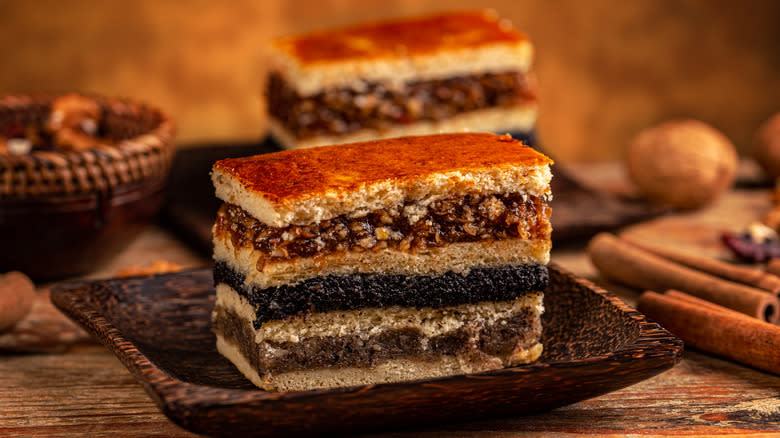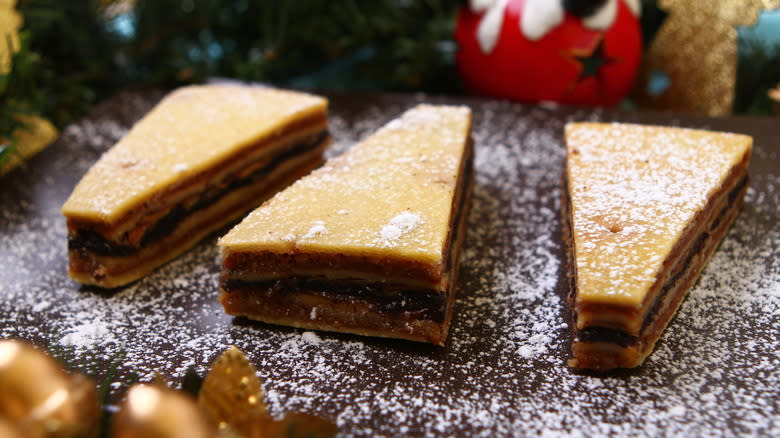Flódni Is The Hungarian-Jewish Treat Made With Luxurious Layers Of Filling

The layered sweet treat flódni is eaten most commonly today in Budapest cafes. Variations of this Hungarian-Jewish pastry and its associated meanings can vary from household to household, however. The combination of different fillings with a sweet, buttery pastry can simultaneously remind an eater of home or a special occasion. But be warned: This complex pastry takes effort to make.
Historical documents trace the earliest recipes of what is recognized as flódni today to Jews in the area of central Europe known as the Carpathian Basin in the inter-war period, with Hungary at its center. The pastry's popularity truly blossomed in Budapest, where it can be found not only during Hanukkah and Purim but all year long. With fillings of nuts, seeds, and fruits cooked separately before being stacked together and baked, the finished result makes a lasting impression. While it is no longer reserved for religious celebrations it can still be found at Hungarian weddings and birthday parties, in addition to being savored as an afternoon pick-me-up.
Frőhlich, a private pastry shop in Budapest was a source of the popularity of the cake in the city, as flódni became what the bakery was most famous for from the 1950s onwards. Sadly Frőhlich closed in the pandemic, but many other Budapest bakeries sell the treat. A celebrated modern baker, Judit Vamos, makes hundreds daily, which are distributed to restaurants and cafes -- yet her recipe remains a secret.
Read more: 30 Types Of Cake, Explained
The Evolution Of Flódni

Flódni's many recipe variations may be, in part, due to the longer history of the treat. The name flódni can be traced to the German fladen, which means pie or pie bread. The fladen often found in the south of Germany, however, is a flatter, thinner cake, without the tiers that flódni offers. In 1695, belés -- cakes with fillings sandwiched between layers of dough -- appeared made with unleavened dough. It wasn't until the 19th century that flódni appeared in cookbooks, following in the footsteps of a kind of paste made with cottage cheese, poppy seeds, fruits, and jams.
Some researchers have linked flódni to 10th-century Hanukkah celebrations, and as early as the 11th century, a recipe made with cheese was mentioned and could be found on Shabbat and New Year's tables until the 16th century. Some of these early recipes have been connected to the flan of medieval France, and as Jewish communities moved to different areas across Europe, the recipe traveled with them. A similar cake Fächertorte was found in Vienna, and in Hungary, flódni took flight and became intertwined with tradition and cultural identity.
The Making Of Flódni

Flódni remains popular in Hungary. While individual bakers keep their recipes close to their chests, the general idea is this: Multiple layers are cooked from scratch, and bakers prepare fillings to bake. Once peeled, apples are steamed in wine and sweetened with honey and cinnamon. Poppy seeds are mixed with lemon, and walnuts are stirred with wine, sugar, and raisins. Homemade plum jam is made in a perfect consistency so that it isn't too runny to seep out from the layers of pastry and can hold the pastry in place.
Historian and former chief rabbi in Hungary, Tamás Raj, admits that preparing flódni demands attention and time, but finding the recipe to make the treat can prove difficult. "Of course, we don't write a recipe, because there are as many customs as there are houses," Raj admitted to Hungarian Food and Wine website. Even the pastry dough has variations, from thinner phyllo pieces to richer, thicker layers. Goose fat, butter, potato starch, and matzoh have all made their way into the dessert, and the finished pastry doesn't always look perfectly sliced. Some flódni is rolled, while others resemble bagels. Some pastries present three fillings instead of four, and when spiked with punchy ingredients like rum, the treat is intended for more mature palates. The zesty, sweet flavor combinations work, however, in a culinary achievement that some say represent the seasons and the hope for different cultures to live together in peace.
Read the original article on Tasting Table.

